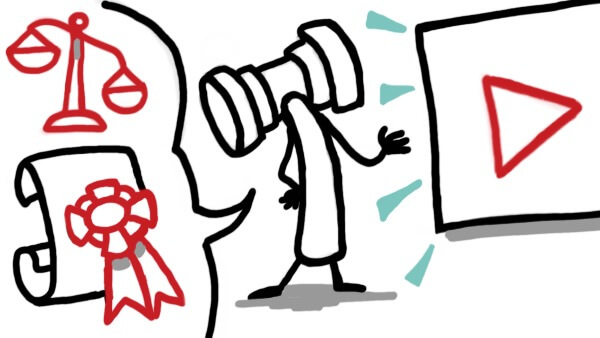Explaining Legal Concepts with Whiteboard Video

While earning my Paralegal certificate, I remember a question coming up a few times relating to just why study, and understanding, of the law was so important. Consistently, the response was short and effective (and I am paraphrasing a bit, as it’s been a while): “It’s important because it’s the field in which people’s freedoms are at stake.” Obviously, not all law deals with criminal cases and potential restrictions of liberty and/or life, but only the law deals with these high-stakes concepts, and only an understanding of the law is relevant in navigating these issues.
The law, then, is a unique field of study and of practice, as it tends to feel either totally absent, or separate, from our lives—or its presence potentially overrides all other concerns. This is the root of the old joke/aphorism that nobody cares about a lawyer until they need one. So it comes as little surprise that when legal concepts need to be explained, the absolute best explainer is necessary.
Heightening Retention
Whiteboard is that explainer. The unique characteristics of whiteboard are perfectly suited to addressing these crucial topics, whether it’s a legal concept in the workplace, a criminal law concept explained in a government initiative, or anywhere in between. Let’s look at these characteristics more closely.
The key and most important element of legal education is retention. You cannot behave legally, and avoid legal consequence for your actions, if you cannot retain an accurate understanding of the law. Whiteboard video is created with the express goal of securing first engagement, and then retention of its message, through design principles guaranteed to help viewers remember that message.
The synchronization of just the right visuals with the voiced script is a guarantor of higher retention rates, as it provides a dual reinforcement of the subject matter, and allows for viewers of various learning types to follow and absorb the material. This is absolutely necessary with a topic like the law, as everyone is equally bound, and must be afforded an equal chance to understand their rights, privileges, and obligations.
This does not necessarily mean that whiteboard video should or can be the only way to explain legal concepts, or that textual materials are no longer relevant. Legal concepts are almost certainly best explained with as many approaches available as possible. Whiteboard video is a strong synthesis of visual and auditory learning, and therefore creates a highly democratic, highly retainable medium for legal explanation.
Making the Law Engaging
Before retention can occur, however, the audience must be engaged by the subject matter. As we can likely all admit, legal concepts do not always have an instantly engaging nature—with the exception of the higher-stakes, more ‘flashy’ scenarios like bank robberies, the law frequently deals in seemingly mundane concepts. Of course, they’re only mundane to a point; even minor infractions can be rather costly.
So, warranted or not, you often have a barrier to get through with legal concepts—and the way to do that is with whiteboard video. With the design principles of motion and surprise—to choose just two of several—engagement will be easy to gain and maintain. Motion is a constant engagement tool, as the brain naturally tracks motion, and moves not just the eyes, but the head to follow it. The artist’s hand, moving around the frame in whiteboard to draw the imagery, is a constant source of motion, and the viewer’s eyes are moving in consistent harmony with this movement.
Surprise, moreover, causes the brain to release dopamine, which is more than simply a ‘happy’ neurotransmitter; it actually causes the brain to become and remain curious. Each time the artist begins a drawing, the viewer’s curiosity is piqued: what will this line end up becoming? And whether or not they’re able to guess, the next drawing begins, continuing the engagement cycle.
This is how you take a topic that might not be instantly exciting, and gain focus and interest almost immediately. More specifically, this how you overcome your ‘dull legal topic’ problem, quickly and easily.
Review Information Easily
Finally, whiteboard video is a medium that is not only appealing, but rewatchable. This is the ultimate way to enable retention, of course: have the message readily available and repeatable. As we enter 2022, people are more interested in video than ever—so before you wonder if it’d be easier to simply print the materials, rest assured that your audience will almost certainly be more willing to watch a video. Save the paper, increase the likelihood of material review, and use whiteboard.
Legal concepts are far too important to be left to anything less than the strongest medium for explanation. Whiteboard proves itself to be that medium through its retention-increasing, engagement-increasing characteristics—synchronized drawings with voiced script, the artist’s moving hand, the surprise of each hand-drawn image appearing on the board, and of course, the ability to rewatch the video.
In the only arena where liberty can be at stake, where finances and employment are frequently on the line, and where years of one’s life can be tied up in processes and complications, explanation must be top-notch and lastingly effective. Let whiteboard video explain your legal concepts to your viewers. They matter too much to be left to anything else.
